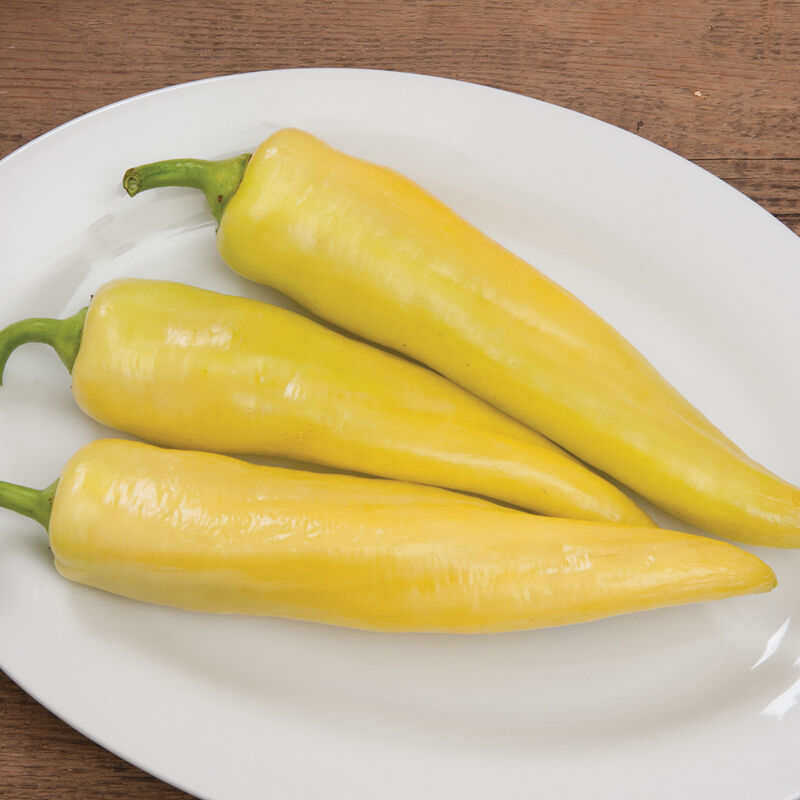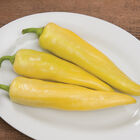Goddess (F1) Banana Pepper Seed
Goddess (F1) Banana Pepper Seed
Sweet banana for pickling or fresh eating.
Long, thick-walled, smooth fruits are borne on large plants. Avg. 8-9" long, the fruits are mild when yellow and moderately sweet when they ripen red. Best for pickling due to their mild flavor, but also suitable for fresh market. Widely adapted.Disease Resistance:
Specs:
- This product does not ship to the following countries: Austria, Australia, Belgium, Bulgaria, Cyprus, Czech Republic, Germany, Denmark, Estonia, Spain, Finland, France, United Kingdom, Greece, Croatia, Hungary, Ireland, Italy, Japan, Republic of Korea, Lithuania, Luxembourg, Latvia, Netherlands, New Zealand, Poland, Portugal, Romania, Sweden, Slovenia, Slovakia, Taiwan.
SCIENTIFIC NAME:
Capsicum spp.CULTURE:
Peppers thrive in well-drained, fertile soils with a pH of 6.5. Abundant phosphorus and calcium is needed for the best results. Cold weather is buffered and earliness increased by using black plastic mulch, especially in combination with lightweight fabric row covers supported by wire hoops. Remove row covers in sunny weather above 85°F (29°C) to prevent blossom drop and heat damage.DAYS TO MATURITY:
Approximate days from transplanting outdoors to first pickings of full size fruit.TRANSPLANTING:
Sow seed in 20-row or shallow flats, 4 seeds/in., 1/4" deep, in late March or about 8 weeks prior to transplanting. If possible, maintain soil temperatures at 80-90°F (27-32°C). Pepper seeds germinate very slowly in cooler soil. When the first true leaves appear, transplant seedlings into 2" cell-type containers or 4" pots. Grow plants at approx. 70°F (21°C) day and 60°F (16°C) nights. Transplant out after frost when the soil is warm and weather is settled. Ideal seedlings have buds, but no open flowers. Space pepper plants 12-18" apart in rows 24-36" apart, or 2 rows on poly/paper mulch, 18" between plants. Water-in transplants using a high phosphorus solution.COLD TREATMENT:
Exposing the seedlings to controlled cold treatments can increase the number of flowers and fruits. When the third true leaf appears, grow the plants at a minimum night temperature of 53-55°F (12-13°C) for 4 weeks. The plants should receive full sunlight. After 4 weeks adjust temperature to 70°F (21°C) day and night. If this technique is used, peppers should be seeded 1-2 weeks earlier than usual.INSECT PESTS:
Control climbing cutworms with Bacillus thuringiensis, or with paper cylinder collars. Control tarnished plant bugs, aphids, and flea beetles with pyrethrin.DISEASES AND PROBLEMS:
To prevent bacterial spot and Phytophthora, drip irrigate only, plant only in well-drained soils, minimize soil compaction, and follow a 4-year crop rotation. Sunscald is caused by an inadequate foliage canopy. Prevent blossom end rot with adequate soil calcium and regular moisture. Big bushy plants with few peppers can be caused by an excess of nitrogen, hot or cold temperature extremes during the flowering period, tarnished plant bug injury, and choice of late, poorly-adapted varieties.BACTERIAL SPOT NOTICE:
Bacterial spot can be seedborne. All Johnny's pepper seed lots are tested for bacterial spot. Note: A disease-free test result does not guarantee a seed lot to be disease-free, only that in the sample tested, the pathogen targeted was not found.HARVEST:
Pick the first peppers promptly when they reach full size to encourage further fruit set. STORAGE: Wash and hold at 45°F (7°C) and 95% relative humidity.TRANSPLANTS:
Avg. 19 plants/ Pkt., 750 plants/1,000 seeds, 19,360 seeds per acre of transplants (avg. 14,520 plants), 12" between plants in rows 36" apart.SEEDS/OZ. (AVG.): 4,300.PACKET:
25 seeds, unless otherwise noted.Johnny's is committed to your success, every step of the way.
We want you, our customer, to be 100% satisfied with all of our seeds, tools, and supplies.
If anything you purchase from us proves unsatisfactory, we will either replace the item or refund the purchase price.





